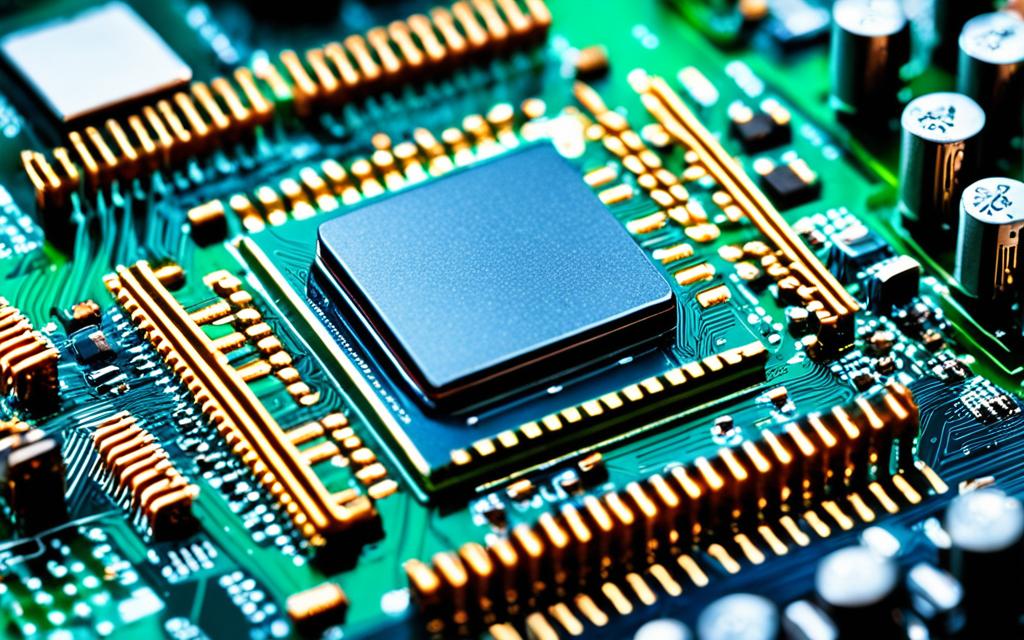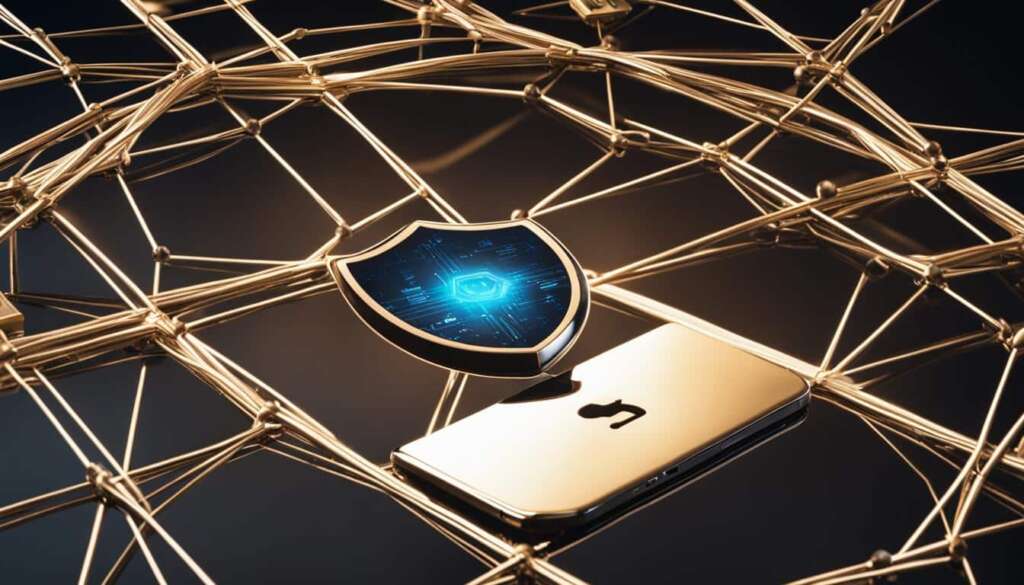Table of Contents
An embedded PC is a computer built for a specific purpose. It’s part of bigger machines or systems. These computers are key in projects where size, weight, power, and cost matter. Embedded systems use hardware and software to do certain jobs. They might work alone or as part of something bigger. Embedded PCs are vital in making smart, connected systems across various tech fields.
Key Takeaways
- Embedded PCs are dedicated computer systems integrated into larger machines or systems.
- They are designed for specific purposes and are used in applications with size, weight, power, and cost constraints.
- Embedded systems combine hardware and software components to perform specific tasks.
- Embedded PCs play a crucial role in shaping connected, intelligent systems in modern technology.
- They are utilized in industries such as manufacturing, transportation, warehousing, logistics, energy, agriculture, and military.
Embedded PCs are essential in many sectors, offering benefits and applications. They serve industries such as manufacturing and transportation. For example, in e-commerce, embedded PCs manage automated robots in warehouses. Electric vehicle stations use them for charging and monitoring. They automate feeding in farms, says1. IEEE describes these computers as key parts of bigger devices, running specific tasks. They’re not always seen, often tucked away in machines or cabinets.
In smart manufacturing, these PCs make processes more efficient. They improve maintenance and boost production. Rail systems use them for safety and monitoring. Embedded computers help cities manage traffic better, making operations smoother and improving experiences. The energy sector relies on them for managing and monitoring production. Warehousing uses them to link sensors and systems for smarter operations.
The history of embedded PCs is filled with growth and innovation. In the 1990s, computers small enough to be called Microboxes sparked this evolution. By the mid-2000s, fanless, high-performance computers were made. This was thanks to processors like AMD’s LX800. In 2009, Intel’s Atom processor line boosted the field further2. Sales soared, with thousands of units sold quickly after the launch2. Major manufacturers adopted this technology, bringing it into mainstream project design2.
Initial versions had many cables, which could fail. But now, embedded PCs have fewer cables and more expansion options. They offer LAN, USB ports, and more2. Advancements in chips and innovation from companies like Aaeon Technology have driven their evolution. By the early 2010s, certified embedded PCs were used in more industries, including rail and oil2.
Despite their benefits, embedded PCs have challenges. They must fit into small spaces and work non-stop in tough conditions1. Companies like Cincoze create robust computers for industrial use and AI. Their PCs are known for their durability and can be expanded easily1. Cincoze also offers a long-term supply of parts, ensuring reliability for years1.
Understanding Embedded Systems and Their Classification
Embedded systems are crucial in many fields like healthcare, and industrial automation3. They are made of hardware and software3. Understanding their classification helps grasp their role and complexity3.
Types of Embedded Systems
There are various kinds of embedded systems. They include real-time, standalone, network, and mobile systems. Let’s look into each category:
- Real-time embedded systems: These are essential in areas needing quick responses, for example, in healthcare and the military4. They are split into soft and hard real-time systems. Soft systems are somewhat flexible with deadlines, but hard systems are not4.
- Standalone embedded systems: These systems work by themselves. Think of devices like MP3 players and microwave ovens4.
- Network embedded systems: These connect to networks to talk to other devices. Examples include home security and ATM machines4.
- Mobile embedded systems: Designed for transport, these can be found in phones and digital cameras4.
Knowing about these embedded systems shows their wide usage and importance. Next, we’ll explore what makes each type unique.
How Embedded Systems Work
Embedded systems are composed of hardware and software that perform specific tasks together. They include parts like microcontrollers, memory, and power supplies. Each part works to enable the system, including an embedded PC, to do what it’s meant to do.
At the heart of an embedded system, microcontrollers or microprocessors act as the brain. They follow software instructions to efficiently carry out tasks. These microcontrollers are tailored for the needs of embedded systems, ensuring effective performance.
The software part includes system and application code that controls the system’s actions. It’s written in languages like C or C++. This software manages how the system works with hardware, inputs, and outputs. It also lets the system interact with other devices or the environment.
Embedded systems use interfaces like USB and SPI for data exchange with other devices. These allow the system to share data, connect with sensors, and talk to other devices. It’s how embedded systems communicate with the world outside.
Power supplies give embedded systems the energy they need to operate. They often use 1.8V to 3.3V power supplies, and some run on batteries. Making sure the power supply is reliable is key to the system’s smooth running.
Embedded systems are crucial in fields like electronics and automotive industry. They play a big part in automation, data collection, and control. Their reliability and efficiency are what make them vital across different sectors.
Together, hardware and software in embedded systems execute tasks with precision. From controlling microcontrollers to managing power, these systems are key in many applications. They push forward innovation in a range of industries.
| Embedded Systems Components | |
|---|---|
| Microcontrollers or Microprocessors | Dedicated hardware for executing software instructions |
| Input/Output Communication Interfaces | USB, I2C, UART, RS-485, SPI, etc. |
| Power Supplies | 1.8V to 3.3V, battery-powered |
Reference: https://www.heavy.ai/technical-glossary/embedded-systems56
Advantages and Applications of Embedded PCs
Embedded PCs are known for their reliability, compact size, and low power consumption. These features make them perfect for many everyday applications in various sectors.
In automation, embedded PCs are essential for smooth operations. They make travel more fun by powering entertainment in coaches. Embedded PCs help control traffic flow, making roads safer. They also update drivers with real-time information through variable message signs. Furthermore, they are key in developing self-driving cars and in tracking deliveries7.
Embedded PCs are also behind the scenes in everyday tools. They help cash machines, advertising boards, and shops run automatically. This automation brings ease and efficiency to our lives. They make modern technology’s benefits possible. From powering electronic billboards to improving factory systems, they are crucial8.
Advantages of Embedded PCs
| Advantages | Description |
|---|---|
| Reliability | Embedded PCs are built to be reliable, with designs that handle vibrations and dissipate heat. This ensures they work well for a long time. |
| Compact Size | Thanks to their small and compact design, embedded PCs fit in many types of equipment or control units. |
| Low Power Consumption | They use very little power and can run without fans. This makes them perfect for places without human supervision and helps save on energy bills. |
Embedded PCs are vital in industry and our daily lives. They improve automation and reliability. They also allow for new tech applications. Indeed, embedded PCs help technology evolve and advance in many fields.
A Brief History of Embedded Computers
Embedded computers have had an interesting evolution over the decades. They’ve transformed many industries. The story starts in the 1960s with Charles Stark “Doc” Draper and his creation, the Apollo Guidance Computer9. This was the first embedded system. It led to the development of the embedded computers we use today.
At that time, the Apollo Guidance Computer had around 145,000 lines of code. This showed how complex and innovative it was9. Now, compare that to the modern Android smartphone. It has up to 15 million lines of code9! This shows how much embedded computing has grown.
In 1971, embedded computers took a big step forward. Texas Instruments introduced the first microcontroller9. That year also saw the first 4-bit microprocessor. Three years later, the Intel 8008 came out. It was the first 8-bit processor9.
Wind River’s VxWorks in 1987 was another big moment. It was the first real embedded operating system9. Windows entered the embedded market in 1996 with Windows Embedded CE 1.0. This helped embedded systems become common in many industries9.
2007 was a milestone year because of the iPhone. It was the first all-in-one embedded mobile device9. It set new standards for what mobile devices could be.
Today, embedded computers are key in many sectors. They’re in industrial automation, healthcare, and transport. Their processing power, variety of I/O options, and rugged designs are essential. Embedded computers have come a long way since the 1960s9.
Conclusion
Embedded PCs are key to our connected, tech-savvy world. They are in everything from smartphones to cars and home gadgets10. They make devices more efficient, responsive, reliable, and energy-saving10. These systems have four main parts: the microprocessor, memory, input/output interfaces, and software. They work together for the best performance10. When designing these systems, we think about how much power they use, how quickly they react, their size, cost, and how reliable they are10.
Over time, embedded PCs have adapted to fit the needs of different fields. They’ve gotten smaller, more trustworthy, and use less power. They now feature AI and machine learning too11. Embedded systems are vital for the automotive industry’s functions and safety11. They’re also key in industrial automation for controlling and managing processes11. In healthcare, these systems are essential for medical devices and gear11. They also play a big role in aerospace, powering avionics and satellites11.
The future for embedded PCs looks bright. They will become even more integrated, efficient, and functional. With AI, IoT, and edge computing pushing forward, the demand for these systems will skyrocket11. We’ll see more innovation in consumer electronics, cars, industry controls, medical equipment, home automation, and smart devices10. Embedded PCs have already shown they can provide reliable and efficient solutions. They are essential for a connected and smart future.
FAQ
What is an embedded PC?
An embedded PC is a special computer. It’s part of a bigger system or machine.
What are embedded systems?
Embedded systems are computers that do specific tasks. They have both hardware and software.
What are the types of embedded systems?
There are different kinds of embedded systems. These include real-time, standalone, network, and mobile systems.
How do embedded systems work?
Embedded systems use hardware and software. They have microcontrollers and memory. These components work together for certain tasks.
What are the advantages of embedded PCs?
Embedded PCs are reliable and small. They use little power. You’ll find them in automation and daily gadgets.
What is the history of embedded computers?
Embedded computers started in the 1960s as big machines. By the 1990s, they became smaller Microbox PCs. The 2000s brought fanless computing. This changed the market with compact, powerful computers.
What role do embedded PCs play in modern technology?
Embedded PCs are key in today’s connected, smart systems. They drive innovation and change industries.
Source Links
- https://www.cincoze.com/Tech-Articles_info.php?id=133 – What is an Embedded Computer? | Technology Articles | Technologies
- https://www.impulse-embedded.co.uk/knowledge-base/what-embedded-computer.htm – What is an embedded computer? · Knowledge base · Impulse Embedded Limited
- https://www.dedicatedcomputing.com/embedded-computing-systems/ – Embedded Computing Systems 101: What are they, Benefits, Applications
- https://www.geeksforgeeks.org/classification-of-embedded-systems/ – Classification of Embedded Systems – GeeksforGeeks
- https://en.wikipedia.org/wiki/Embedded_system – Embedded system
- https://www.spiceworks.com/tech/tech-general/articles/what-are-embedded-systems/ – Embedded Systems: Meanings, Components, and Applications – Spiceworks
- https://resources.pcb.cadence.com/blog/2023-advantages-of-embedded-systems – Advantages of Embedded Systems
- https://www.jwipc.com/advantages-and-applications-of-embedded-computer.html – Advantages and Applications of Embedded Computer – JWIPC Technology Co., Ltd.
- https://bluefruit.co.uk/processes/a-brief-history-of-embedded-operating-systems/ – A brief history of embedded operating systems – Bluefruit Software
- https://www.fodenn.com/news/what-is-an-embedded-computer-system.html – What Is An Embedded Computer System
- https://www.waysion.com/rugged-tablet/embedded-computers-revolutionizing-technology/ – Embedded Computers: Revolutionizing Technology Across Industries – Waysion








